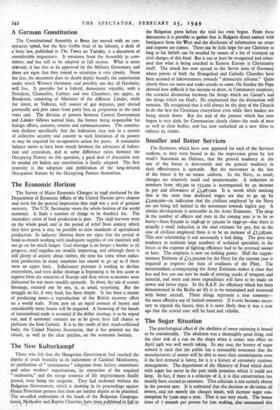A German Constitution
The Constitutional Assembly at Bonn has moved with no con- spicuous speed, but the first visible fruit of its labours, a draft of a basic law, published in The Times on Tuesday, is a document of considerable importance. It emanates from the Assembly in com- mittee, and has still to be adopted in full session. What is more relevant, it has also to be approved by the Military Governors, and there are signs that they intend to scrutinise it very closely. None the less, the document does no doubt depict broadly the constitution under which Western Germany, and possibly one day all Germany, will live. It provides for a federal, democratic republic, with a President, Chancellor, Cabinet and two Chambers, the upper, or Bundesrat, consisting of Ministers of the different Lander, while the lower, or Volksrat, will consist of 400 deputies, part elected personally and part taken from party lists in proportion to the total votes cast. The division of powers between Central Government and Lander follows normal lines, the former being responsible for foreign affairs, customs, treaties and communications. The constitu- tion declares specifically that the federation may join in a system of collective security and consent to such limitation of its powers as may be required for co-operative action for peace. A reasonable balance seems to have been struck between the advocates of federa- tion and centralism, and as some difference exists between the Occupying Powers on this question, a good deal of discussion may be needed yet before any constitution is finally adopted. The first necessity is the adoption and publication of the long-delayed Occupation Statute by the Occupying Powers themselves.


































 Previous page
Previous page